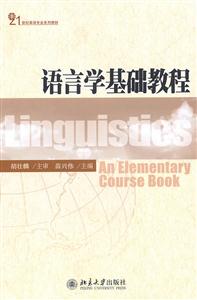语言学基础教程

|
语言学基础教程作者:胡壮麟 开 本:16开 书号ISBN:9787301138397 定价:32.0 出版时间:2010-07-01 出版社:北京大学出版社 |
6.1 introduction
6.2 pragmatics as a new branch of linguistics
6.2.1 defining pragmatics
6.2.2 syntax, semantics and pragmatics
6.3 speech act theory
6.3.1 constatives and performatives
6.3.2 locution, illocution, and perlocution
6.3.3 felicity conditions
6.3.4 classification of speech acts
6.4 theory of conversational implicature
6.4.1 the notion of implicature
6.4.2 cooperative principle and its maxims
6.4.3 flouting the maxims
6.5 politeness principle
6.5.1 politeness: the principle and the maxims
6.5.2 clashes between the maxims
6.6 summary
questions and exercises
chapter 7 discourse analysis: language above the sentence
7.1 introduction
7.2 what is discourse analysis?
7.3 cohesion
7.3.1 reference
7.3.2 substitution
7.3.3 ellipsis
7.3.4 conjunction
7.3.5 lexical cohesion
7.4 coherence
7.5 the structure of discourse
7.5.1 thematic structure and information structure
7.5.2 the structure of conversations
7.5.3 patterns in written discourse
7.6 connections
questions and exercises
chapter 8 historical linguistics: language through time
8.1 introduction
8.2 when language changes
8.3 how language changes
8.3.1 phonological change
8.3.2 lexical change
8.3.3 grammatical change
8.4 why language changes
8.4.1 external causes
8.4.2 internal causes
8.5 summary
questions and exercises
chapter 9 stylistics: language and literature
9.1 introduction
9.2 important views on style
9.2.1 style as deviation
9.2.2 style as choice
9.2.3 style as foregrounding
9.3 stylistic analysis
9.3.1 phonological analysis
9.3.2 graphological analysis
9.3.3 lexical analysis
9.3.4 syntactic analysis
9.3.5 semantic analysis
9.3.6 pragmatic analysis
questions and exercises
chapter 10 sociolinguistics: language and society
10.1 introduction
10.2 the relations between language and society
10.3 speech community and speech variety
10.4 dialect
10.4.1 regional dialect
10.4.2 social dialect
10.4.3 standard dialect
10.5 register
10.6 language contact and contact languages
10.6.1 lingua franca
10.6.2 pidgin
10.6.3 creole
10.7 choosing a code
10.7.1 diglossia
10.7.2 bilingualism
10.7.3 code-switching
questions and exercises
chapter 11 intercultural communication: language and culture
11.1 introduction
11.2 definitions of culture
11.3 the relationship between language and culture
11.4 naming the world through language
11.4.1 color terms
11.4.2 kinship terms
11.4.3 culture-loaded words
11.5 communicative patterns across cultures
11.5.1 address forms
11.5.2 greetings
11.5.3 giving and accepting compliments
11.5.4 high context versus low context
11.6 language and thought: sapir-whorf hypothesis
11.7 intercultural communication
11.7.1 intercultural communication as a field of research
11.7.2 conquering obstacles in intercultural communication
11.7.3 value dimensions
11.8 summary
questions and exercises
chapter 12 psycholinguistics: language and psychology
12.1 introduction
12.2 language and the brain: the biological foundations of language
12.2.1 cerebral lateralization and language functions
12.2.2 evidence of lateralization
12.3 language comprehension
12.3.1 human information processing system
12.3.2 the mental lexicon
12.3.3 sentence comprehension
12.3.4 discourse comprehension
12.4 language production
12.5 language acquisition
12.5.1 first language, second language and foreign language
12.5.2 first language acquisition
12.5.3 second language acquisition
questions and exercises
chapter 13 cognitive linguistics: language and cognition
13.1 introduction
13.2 categories and categorization
13.3 conceptual metaphors
13.4 conceptual metonymies
13.5 image schemas
13.6 iconicity
13.6.1 iconicity of order
13.6.2 iconicity of distance
13.6.3 iconicity of complexity
questions and exercises
chapter 14 applied linguistics: language teaching and learning
14.1 introduction
14.2 how is language learned?
14.2.1 behaviorism
14.2.2 the innateness hypothesis: universal grammar
14.2.3 interlanguage theory
14.2.4 the input hypothesis
14.2.5 the output hypothesis
14.3 individual differences in language learning
14.3.1 language aptitude
14.3.2 learning style
14.3.3 motivation
社会科学 语言文字
在线阅读
- 最新内容
- 相关内容
- 网友推荐
- 图文推荐
上一篇:魏书生的故事
下一篇:科技论文规范写作与编辑
零零教育社区:论坛热帖子
| [高考] 2022 西安电子科技大学《软件工程》大作业答案 (2022-04-25) |
| [家长教育] 孩子为什么会和父母感情疏离? (2019-07-14) |
| [教师分享] 给远方姐姐的一封信 (2018-11-07) |
| [教师分享] 伸缩门 (2018-11-07) |
| [教师分享] 回家乡 (2018-11-07) |
| [教师分享] 是风味也是人间 (2018-11-07) |
| [教师分享] 一句格言的启示 (2018-11-07) |
| [教师分享] 无规矩不成方圆 (2018-11-07) |
| [教师分享] 第十届全国教育名家论坛有感(二) (2018-11-07) |
| [教师分享] 贪玩的小狗 (2018-11-07) |






